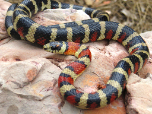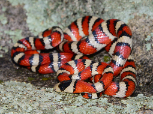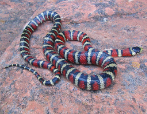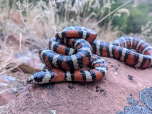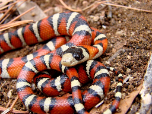Arizona (or Sonoran) Mountain Kingsnake (Lampropeltis pyromelana)
Description: It can grow up to 36 inches in length. Snout white, rarely with flecks of black or red; white annuli on body 46 to 85. Distinguished from L. zonata and L. triangulum by its white snout and higher number of white annuli. In zonata and triangulum the snout is black or black with red markings. White annuli are fewer in all triangulum, and only a few zonata attain the minimum number in pyromelana. The distributions of pyromelana and zonata are allopatric. L. pyromelana and L. triangulum overlap, but are readily distinguished as indicated above, and additionally by the number of ventral scales: 175-198 in triangulum, 213-238 in pyromelana.
Habitat: The species' habitats are primarily rocky, montane, and often near streams or springs, but also include lower elevations in mesic canyons. Vegetation may include pinyon-juniper woodland, oak-juniper woodland, pine-oak woodland, pine-Douglas-fir woodland, or chaparral. During daylight hours, this snake may be found among rocks, logs, or dense clumps of vegetation, under objects, or exposed.
Range: Range extends discontinuously from east-central Nevada and central and western Utah southward to areas near (mostly north of) the Mogollon Rim in Arizona and New Mexico. Occupied areas are often surrounded by large areas of unsuitable arid habitat
Found in these States:
AZ |
NM |
NV |
UT
Diet: L. pyromelana feeds on lizards, rodents and nestling birds.
Reproduction: Oviparous. Females lay an average of three to six eggs per cycle, which hatch within 66 to 83 days. Mating takes place in spring and a clutch of up to 9 eggs is laid in late spring or early summer. Hatchlings emerge in late summer.
Status: Listed as Least Concern in view of the relatively large extent of occurrence and large number of locations, and because the species is unlikely to be declining fast enough to qualify for listing in a more threatened category. This species faces no known major threats in most of its range.
»» Kingdom: Animalia - Animals
»» Phylum: Chordata - Chordates
»» Subphylum: Vertebrata - Vertebrates
»» Class: Reptilia - Reptiles
»» Order: Squamata - Scaled Reptiles
»» Suborder: Serpentes
»» Superfamily: Colubroidea
»» Family: Colubridae - Colubrids
»» Genus: Lampropeltis
»» Species: Lampropeltis pyromelana - Arizona (or Sonoran) Mountain Kingsnake
»» Subspecies:
»» Lampropeltis pyromelana infralabialis - Utah Mountain Kingsnake
»» Lampropeltis pyromelana pyromelana - Arizona Mountain Kingsnake
This article uses material from the Wikipedia article "Lampropeltis pyromelana", which is released under the Creative Commons Attribution-Share-Alike License 3.0. Content may have been omitted from the original, but no content has been changed or extended.
|




